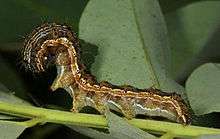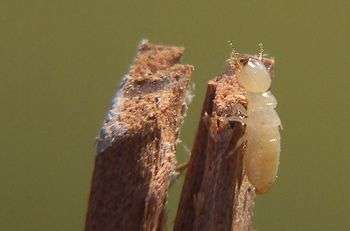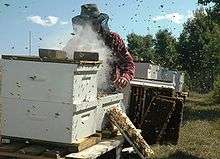Pest (organism)

A pest is a plant or animal detrimental to humans or human concerns including crops, livestock, and forestry. The term is also used of organisms that cause a nuisance, such as in the home. An older usage is of a deadly epidemic disease, specifically plague. In its broadest sense, a pest is a competitor of humanity.[1][2]
Concept
A pest is any living organism, whether animal, plant or fungus, which is invasive or troublesome to plants or animals, human or human concerns, livestock, or human structures. It is a loose concept, as an organism can be a pest in one setting but beneficial, domesticated or acceptable in another.
147.jpg)
Animals are called pests when they cause damage to agriculture by feeding on crops or parasitising livestock, such as codling moth on apples, or boll weevil on cotton. An animal could also be a pest when it causes damage to a wild ecosystem or carries germs within human habitats. Examples of these include those organisms which vector human disease, such as rats and fleas which carry the plague disease, mosquitoes which vector malaria, and ticks which carry Lyme disease.
A species can be a pest in one setting but beneficial or domesticated in another (for example, European rabbits introduced to Australia caused ecological damage beyond the scale they inflicted in their natural habitat). Many weeds are also seen as useful under certain conditions, for instance Patterson's curse is often valued as food for honeybees and as a wildflower, even though it can poison livestock.
The term "plant pest" has a specific definition in terms of the International Plant Protection Convention and phytosanitary measures worldwide. A pest is any species, strain or biotype of plant, animal, or pathogenic agent injurious to plants or plant products.[3] Plants may be considered pests themselves if an invasive species.
The animal groups of greatest importance as pests (in order of economic importance) are insects, mites, nematodes and gastropods.[4] Plant pests can be classed as monophagous, oligophagous, and polyphagous according to how many hosts they have. Alternatively, they can be divided by feeding type, whether biting and chewing; piercing and sucking; or Lapping and chewing. Another approach is to class them by population presence as * key pests, occasional pests, and potential pests. In terms of population biology, there are population growth rate (r) pests; carrying capacity (k) pests; and r-k pests.
By taxon
Vertebrate pests
Birds
- Pigeons and seagulls eat human food and carry disease
- Many birds, such as crows, eat crops
- Canada goose; widely regarded as pests in the United States (see Canada goose#Relationship with humans), and in New Zealand (see Canada geese in New Zealand).
- Woodpeckers peck at rooftops and also nest in them. They cause structural damage to houses.
- The common myna was declared by IUCN Species Survival Commission as one of the world's most invasive species and one of only three birds in the top 100 species that pose an impact to biodiversity, agriculture and human interests.[5] In particular, the species poses a serious threat to the ecosystems of Australia where it was named "The Most Important Pest/Problem".[6]
Amphibians
- Cane toads have had serious negative effects on many ecosystems to which they have been introduced, especially in Australia. The toad's skin is toxic, killing many wild and domestic animals that attempt to eat it.
Mammals
- Mice, rats, and other small rodents damage crops and stored produce
- Rabbits decimate native plant populations in Australia, where they are an introduced species.
- Foxes, opossums, raccoons, and bears eat waste
- Beavers destroy trees
- Gophers, groundhogs, and moles destroy lawns
- Feral cats and feral dogs eat human food and carry disease
- White-tailed deer are now seen as pests in many suburban and exurban areas of the US, though not in more rural areas.
- Coyotes and wolves prey upon livestock
- Vampire bats drink blood of livestock[7]
- Eastern grey squirrels are seen as pests in Britain and Ireland because of the decline of red squirrel populations
- Wild boars damage crops, spread disease, and prey upon livestock
Invertebrates
Insects and arachnids
Agricultural and domestic arthropods


- Examples of agricultural and horticultural insect pests include:
- aphids and other Hemipteran pests,
- thrips,
- Lepidopteran, Dipteran, and Coleopteran larvae,
- spider mites,
- locusts and crickets.
- Ants, cockroaches, flies and wasps
- Termites, woodworm and wood ants cause structural damage
- Bookworms, silverfish, carpet beetles and clothes moths cause non-structural damage
Tree and forest pests
- Gypsy moths attack hardwood trees (see Gypsy moths in the United States)
Ectoparasites
- Chiggers cause skin irritation
- Sarcoptes scabiei causes scabies
- Ticks and mites cause irritation and can spread disease
- Lice, fleas and bed bugs can all cause skin irritation
- Mosquitoes, tsetse flies and kissing bugs cause irritation and carry disease
Nematodes
Gastropod molluscs
These include slugs and land snail pests:
Some slugs are pests in agriculture and gardens.[4] Deroceras reticulatum is a worldwide slug pest.[4] Local importance slug pests include: Deroceras spp.,[4] Milax spp.,[4] Tandonia sp.,[4] Limax spp.,[4] Arion spp.[4] and some species of Veronicellidae:[4] Veronicella sloanei.[8]
- Helix aspersa damages citrus fruits in California,[4]
- Cernuella virgata, Theba pisana and Cochlicella spp. decrease quality of grains when harvested with the product in South Australia.[4]
- Achatina fulica damages vegetables and ornamental plants in the Pacific region.
- Succinea costaricana damages ornamental plants in Costa Rica.[9]
- Ovachlamys fulgens damages ornamental plants and orchids in Costa Rica.[10]
- Other pest species include Amphibulima patula dominicensis,[8] Zachrysia provisoria[8] and Bradybaena similaris.[8]
Plant diseases
Weeds
See also
References
- ↑ Merriam-Webster dictionary, accessed 22 August 2012.
- ↑ "Pest vermin". Britannica. Retrieved 24 August 2016.
- ↑ FAO Corporate Document Repository: Guidelines for Phytosanitary Certificates. Retrieved 1 August 2012
- 1 2 3 4 5 6 7 8 9 10 11 Speiser B. (2002). "Chapter 219. Molluscicides". 506–508. doi:10.1201/NOE0824706326.ch219 PDF In: Pimentel D. (ed.) (2002). Encyclopedia of Pest Management. ISBN 978-0-8247-0632-6.
- ↑ Lowe S., Browne M., Boudjelas S. and de Poorter M. (2000). 100 of the World’s Worst Invasive Alien Species. A selection from the Global Invasive Species Database. The Invasive Species Specialist Group (ISSG), a specialist group of the Species Survival Commission (SSC) of the World Conservation Union (IUCN), Auckland.
- ↑ "ABC Wildwatch". Abc.net.au. Retrieved 2012-08-07.
- ↑ Greenhall, Arthur M. 1961. Bats in Agriculture. A Ministry of Agriculture Publication. Trinidad and Tobago
- 1 2 3 4

- ↑ Villalobos M. C., Monge-Nájera J., Barrientos Z. & Franco J. (1995). "Life cycle and field abundance of the snail Succinea costaricana (Stylommatophora: Succineidae), a tropical pest". Revista de Biología Tropical 43: 181-188. PDF Archived 2011-07-17 at the Wayback Machine..
- ↑ Barrientos Z. (1998). "Life history of the terrestrial snail Ovachlamys fulgens (Stylommatophora: Helicarionidae) under laboratory conditions". Revista de Biología Tropical 46(2): 369-384. PDF. HTM in the Google chache.
Further reading
- Burch, John B.. 1960. Some snails and slugs of quarantine significance to the United States. U.S. Dept. Agriculture, Agricultural Research Service 82(1): 73 pp
- Hockings, F.D, 2014,"Pests, Diseases and Beneficials", CSIRO Publishing, Melbourne, ISBN 9781486300211
External links



- UF/IFAS Pest Alert Web site - arthropods, nematodes and plant diseases affecting humans, livestock/pets, agricultural and ornamental plants.
